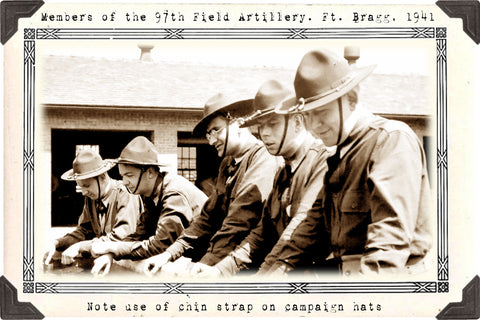
During the publication of the blog series regarding the liner leather chin strap, I had several comments regarding the actual purpose of this strap. Questions ranged from wanting to know if the strap was actually intended to be used as a chin strap, if its purpose was to help hold the liner and pot together when assembled and, based on the ease with which the chin strap leather broke, why the Army even bothered with them.
These questions have merit so I thought I would answer them with a quick rundown over a pint….

While it is true that a liner chin strap stretched up over the brim of the M1 helmet assembly will help keep them together, this was an inadvertent side effect not an intentional one. The loose liner within the pot phenomenon most commonly presents with the high-pressure liner body where a helmet body pressed to the maximum tolerance of opening and depth is mated with a liner at the minimum mold size tolerance. The same condition rarely occurred with paper liners as they formed a snug fit inside the pot, the chin strap often left adjusted to the liner.

It has also been noted, from period photographic evidence, that some airborne soldiers stretched the liner chin strap over the top of the helmet to help keep the liner and helmet together during a drop. This was also not an intended function of the strap; rather it was an expedient solution to the extreme circumstance of jumping from an airplane.

The short answer is no, the chin strap was not designed to hold the helmet assembly together and yes, the Army intended the strap to be used as a chin strap which is why it was part of the initial design and why it persisted well into the 1950s.

The original intent behind the advent of a separate liner assembly for the new helmet, and therefore the sales pitch given to the Army brass, was that this separate liner system would be an acceptable replacement for the campaign hat, garrison cap, overseas cap and the tropical “pith style” helmet. In retrospect the only real casualty was the campaign hat which found itself relegated to use by instructors and trainers.



Of the four items of headgear the liner was proposed to have replaced, only one did not have an integrated chin strap: the garrison cap. Although the other three types of headgear had a chin strap they were commonly left as issued and not adjusted for actual use as a chin strap. The initial permanently attached version of the liner leather chin strap and the difficulty involved in adjusting its size commonly found the strap left in its “as issued” position stretched over the brim of the liner body.

After the development of the removable chin strap and the implementation of the cam levered adjustment buckle, more evidence of the intended use of the strap can be found. Period photographs showing the chin strap in use in theaters of war are rare however,


finding them in use during activities like training, guard duty, formations, and ceremonies is quite common.



In non-combat activities like these, although there isn’t an easy way to prove it, I suspect that the chin strap become more about the helmet’s formal “look” and less about its intended function which, no doubt, added to the straps longevity.

Collector's Note: This would explain the variety of liner chin straps which have been painted for use by MPs and instructors and, in lieu of an actual chin strap, the use of tape or paint over the liner brim intended to simulate one.


great information that solves a lot of answers.
Another outstanding contribution to the history of the M-1 helmet and liner .
At ease !
Leave a comment